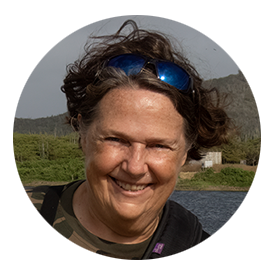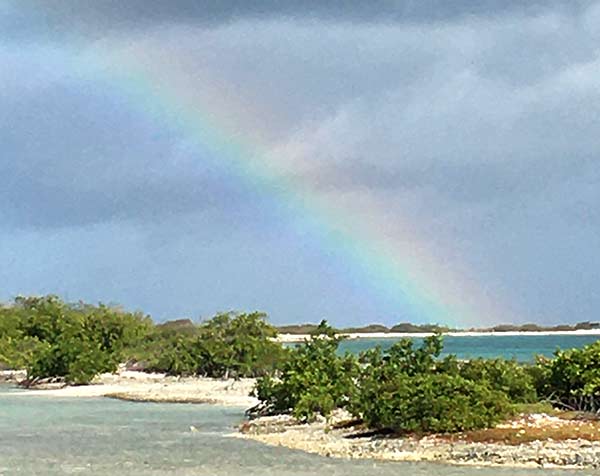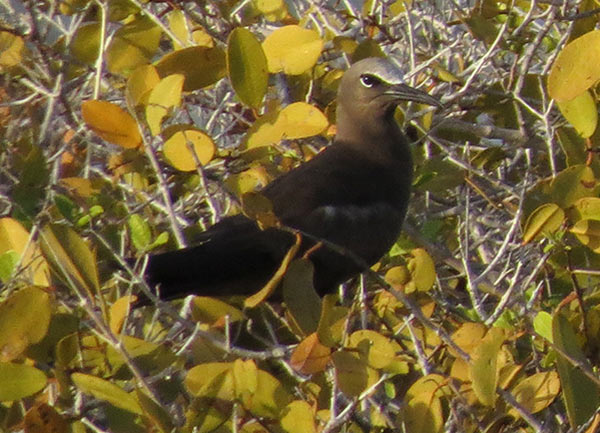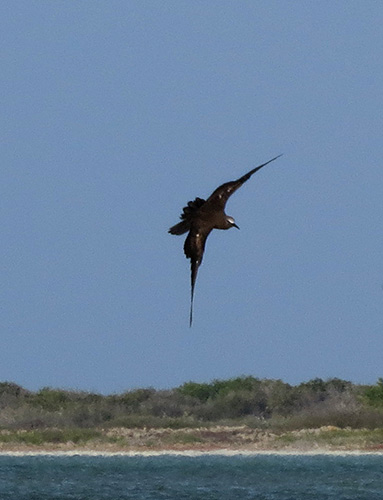The Brown Noddy
This seabird is not often found on land!
Posted July 8, 2020
This week’s sighting of the rare-for-Bonaire Brown Noddy is only the 11th recorded sighting of this seabird on land around Bonaire.
Earlier this week, I made my way down to Bonaire’s southwestern coast, as it had been some time since I was there. I hoped to be able to spot some tern chicks, but what actually happened was much more exciting!
As I drove south, a small rain squall moved quickly across the island’s southern half, providing a beautiful rainbow. As I pulled off to the side of the road to take an image, I playfully thought to myself that perhaps I’d find some tern chicks at the end of the rainbow. Instead, I did find a birder’s equivalent to the ol’ pot of gold, and that was the rare Brown Noddy!
About the Brown Noddy.
The Brown Noddy (Anous stolidus) is a seabird in the family Laridae. The largest of the noddies, it can be distinguished from its close relative, the Black Noddy, by its larger size and plumage, which is dark brown rather than black. The Brown Noddy is a tropical seabird with a worldwide distribution, ranging from Hawaii to Australia in the Pacific Ocean, from the Red Sea to the Seychelles in the Indian Ocean, and here, in the entire Caribbean region.
What’s so rare about a bird that inhabits the globe’s tropics?
The reason the Brown Noddy is considered rare, at least here on Bonaire, is that it is hardly ever encountered on land.
The Brown Noddy is 38–45 cm (15–18 in) in length with a wingspan of 75–86 cm (30–34 in). The plumage is a dark chocolate-brown with a pale-grey or white crown and forehead. It has a narrow incomplete white eye-ring. The tail is long and wedge-shaped, and the feet and legs are dark.
The Brown Noddy usually nests on elevated situations on cliffs or in short trees or shrubs. It only occasionally nests on the ground. A single egg is laid by the female of a pair each breeding season. The nest itself is usually a platform nest, made of sticks and twigs.
In their nuptial displays, the female and male bow and nod to each other, hence its name. Courtship feeding and flights accompany this, as is seen in other terns, in addition to the transfer of a small, freshly caught fish from the male to the female.
This bird will lay a clutch of one pink cream egg with lilac and chestnut maculation. The egg usually measures around 52 by 35 millimeters (2.0 by 1.4 in). The egg is incubated by both sexes for 33 to 36 days, with each parent incubating for one or two days while their mate is feeding at sea. After the chick hatches, it grows quickly; usually reaching the weight of the parents in three weeks. Once it fledges, about six to seven weeks after hatching, it can sometimes weigh more than the parents, although this weight is lost quickly once it starts to fly. At this point, the fledgling is starting to rely on its parents less and less as it learns how to provide for itself.
In this area, breeding has been recorded on the island of Aruba, but not here on Bonaire.
The Brown Noddy forages by swooping over the water and dipping down to catch small squid and fish.
Bonaire is seeing unusual terns this summer.
It was only a few weeks ago that the rare vagrant White-winged Tern was observed for about a week on Bonaire, and now we have the Brown Noddy. Perhaps, with the island closed for tourism due to COVID-19 over the last four months, we are seeing nature take back its prior habitat. I must admit, it’s nice to see nature recovering from human interference.
About the author
Susan has been living on Bonaire for over 30 years. She is a certified bird guide, a PADI SCUBA Diving Master Instructor, and an underwater and topside photographer.

Reach out to Susan
Contact Susan via email, Facebook Messenger, give Susan a call, or simply use the online form below.
If you have any questions in regard to your birding tour on Bonaire, feel free to contact Susan to get answers. She is always happy to elaborate on routes or best times for a tour based upon your own personal preferences. Tours can be tailored to your own interests, whether that be birds, photography, or both!
It is also recommended that you do some homework about Bonaire's birds before you visit. By knowing a little bit about the birds which might be encountered on tour, your enjoyment will be heightened! Be sure to check out these resources for Bonaire Birding. Reading the Bonaire Bird Blog will also accustom you to the birds that habitually are encountered on Bonaire.
Facebook Messenger
Get in touch via Facebook Messenger
Telephone
Get In Touch
Get in touch with Susan to check availability for the dates you are visiting Bonaire.
Consent: By using this form you agree with the storage and handling of your data by this website.




